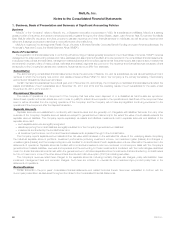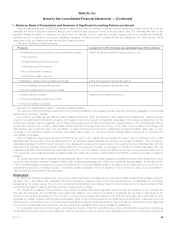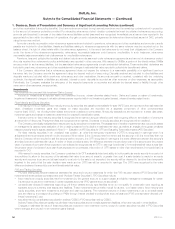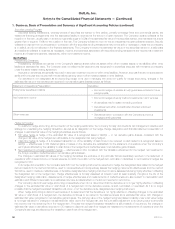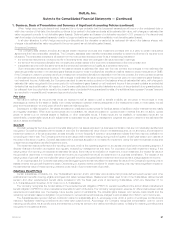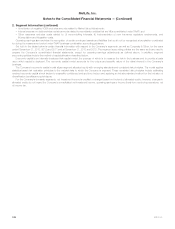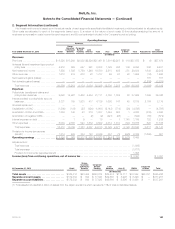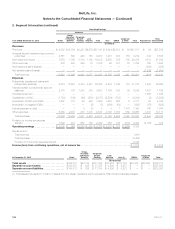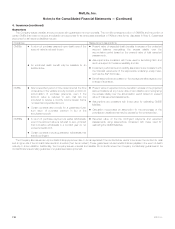MetLife 2013 Annual Report Download - page 108
Download and view the complete annual report
Please find page 108 of the 2013 MetLife annual report below. You can navigate through the pages in the report by either clicking on the pages listed below, or by using the keyword search tool below to find specific information within the annual report.
MetLife, Inc.
Notes to the Consolidated Financial Statements — (Continued)
1. Business, Basis of Presentation and Summary of Significant Accounting Policies (continued)
reporting unit is less than its carrying value as a basis for determining whether it needs to perform the quantitative two-step goodwill impairment test.
Only if an entity determines, based on qualitative assessment, that it is more likely than not that a reporting unit’s fair value is less than its carrying value
will it be required to calculate the fair value of the reporting unit. The qualitative assessment is optional and the Company is permitted to bypass it for any
reporting unit in any period and begin its impairment analysis with the quantitative calculation. The Company is permitted to perform the qualitative
assessment in any subsequent period.
Effective January 1, 2012, the Company adopted new guidance regarding fair value measurements that establishes common requirements for measuring
fair value and for disclosing information about fair value measurements in accordance with GAAP and International Financial Reporting Standards. Some of the
amendments clarify the Financial Accounting Standards Board’s (“FASB”) intent on the application of existing fair value measurement requirements. Other
amendments change a particular principle or requirement for measuring fair value or for disclosing information about fair value measurements. The adoption did
not have a material impact on the Company’s financial statements other than the expanded disclosures in Note 10.
Future Adoption of New Accounting Pronouncements
In March 2013, the FASB issued new guidance regarding foreign currency (Accounting Standards Update (“ASU”) 2013-05, Foreign Currency
Matters (Topic 830): Parent’s Accounting for the Cumulative Translation Adjustment upon Derecognition of Certain Subsidiaries or Groups of Assets
within a Foreign Entity or of an Investment in a Foreign Entity), effective prospectively for fiscal years and interim reporting periods within those years
beginning after December 15, 2013. The amendments require an entity that ceases to have a controlling financial interest in a subsidiary or group of
assets within a foreign entity to apply the guidance in Subtopic 830-30, Foreign Currency Matters — Translation of Financial Statements, to release any
related cumulative translation adjustment into net income. Accordingly, the cumulative translation adjustment should be released into net income only if
the sale or transfer results in the complete or substantially complete liquidation of the foreign entity in which the subsidiary or group of assets had
resided. For an equity method investment that is a foreign entity, the partial sale guidance in section 830-30-40, Derecognition, still applies. As such, a
pro rata portion of the cumulative translation adjustment should be released into net income upon a partial sale of such an equity method investment.
The Company does not expect the adoption of this new guidance to have a material impact on its financial statements.
In February 2013, the FASB issued new guidance regarding liabilities (ASU 2013-04, Liabilities (Topic 405): Obligations Resulting from Joint and
Several Liability Arrangements for Which the Total Amount of the Obligation Is Fixed at the Reporting Date), effective retrospectively for fiscal years
beginning after December 15, 2013 and interim periods within those years. The amendments require an entity to measure obligations resulting from joint
and several liability arrangements for which the total amount of the obligation within the scope of the guidance is fixed at the reporting date, as the sum of
the amount the reporting entity agreed to pay on the basis of its arrangement among its co-obligors and any additional amount the reporting entity expects
to pay on behalf of its co-obligors. In addition, the amendments require an entity to disclose the nature and amount of the obligation, as well as other
information about the obligation. The Company does not expect the adoption of this new guidance to have a material impact on its financial statements.
In July 2011, the FASB issued new guidance on other expenses (ASU 2011-06, Other Expenses (Topic 720): Fees Paid to the Federal Government
by Health Insurers), effective for calendar years beginning after December 31, 2013. The objective of this standard is to address how health insurers
should recognize and classify in their income statements fees mandated by the Patient Protection and Affordable Care Act, as amended by the Health
Care and Education Reconciliation Act. The amendments in this standard specify that the liability for the fee should be estimated and recorded in full
once the entity provides qualifying health insurance in the applicable calendar year in which the fee is payable with a corresponding deferred cost that is
amortized to expense using the straight-line method of allocation unless another method better allocates the fee over the calendar year that it is payable.
In accordance with the adoption of the new accounting pronouncement on January 1, 2014, the Company recorded $57 million in other liabilities, and a
corresponding deferred cost, in other assets.
2. Segment Information
MetLife is organized into six segments, reflecting three broad geographic regions: Retail; Group, Voluntary & Worksite Benefits; Corporate Benefit
Funding; and Latin America (collectively, the “Americas”); Asia; and EMEA. In addition, the Company reports certain of its results of operations in
Corporate & Other, which includes MetLife Home Loans LLC (“MLHL”), the surviving, non-bank entity of the merger of MetLife Bank, National
Association (“MetLife Bank”) with and into MLHL (see Note 3) and other business activities.
Americas
The Americas consists of the following segments:
Retail
The Retail segment offers a broad range of protection products and services and a variety of annuities to individuals and employees of corporations
and other institutions, and is organized into two businesses: Life & Other and Annuities. Life & Other insurance products and services include variable
life, universal life, term life and whole life products. Additionally, through broker-dealer affiliates, the Company offers a full range of mutual funds and
other securities products. Life & Other products and services also include individual disability income products and personal lines property & casualty
insurance, including private passenger automobile, homeowners and personal excess liability insurance. Annuities includes a variety of variable and
fixed annuities which provide for both asset accumulation and asset distribution needs.
Group, Voluntary & Worksite Benefits
The Group, Voluntary & Worksite Benefits segment offers a broad range of protection products and services to individuals and corporations, as well
as other institutions and their respective employees, and is organized into two businesses: Group and Voluntary & Worksite. Group insurance products
and services include variable life, universal life and term life products. Group insurance products and services also include dental, group short- and
long-term disability and accidental death & dismemberment coverages. The Voluntary & Worksite business includes personal lines property & casualty
insurance, including private passenger automobile, homeowners and personal excess liability insurance offered to employees on a voluntary basis. The
Voluntary & Worksite business also includes LTC, prepaid legal plans and critical illness products.
100 MetLife, Inc.


